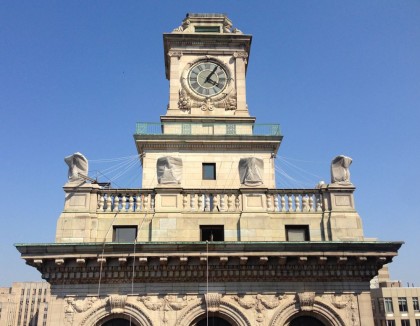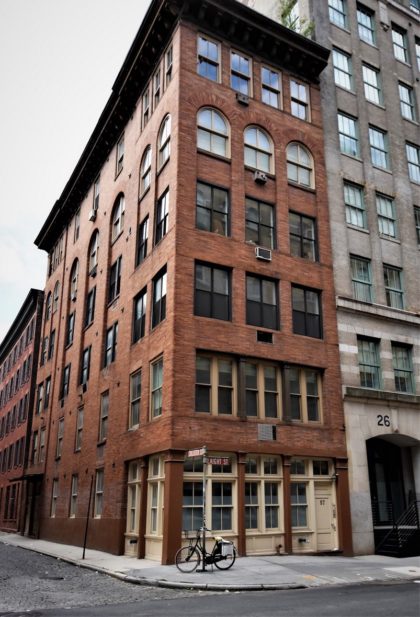Categories
Left column house ads
In the News: Developer Battle Imperils Clocktower Conversion
August 11, 2017 Community News, History, Real Estate
 ••• El Ad and Peebles Corporation are fighting in court over the conversion of the Clocktower Building at 346 Broadway: “Elad claims Peebles ‘never intended to redevelop the property’ and is being unreasonable in refusing to sign off on the condo offering plan and get the project moving in time avoid losing it back to the city. Peebles, on the other hand, claims Elad sandbagged his option to exit the property, and said that ‘if anything is unreasonable, I submit that it is El Ad’s demand that’ he sign a questionable offering plan ‘under penalty of perjury.’ […] The developers said their lenders require them to sell at least 35 units by August 2 2018, and the deed allows the city to take the property back if they haven’t completed the project within five years of the sale.” (El Ad/Elad refers to itself with both spellings.) —Real Deal (photo courtesy Brett)
••• El Ad and Peebles Corporation are fighting in court over the conversion of the Clocktower Building at 346 Broadway: “Elad claims Peebles ‘never intended to redevelop the property’ and is being unreasonable in refusing to sign off on the condo offering plan and get the project moving in time avoid losing it back to the city. Peebles, on the other hand, claims Elad sandbagged his option to exit the property, and said that ‘if anything is unreasonable, I submit that it is El Ad’s demand that’ he sign a questionable offering plan ‘under penalty of perjury.’ […] The developers said their lenders require them to sell at least 35 units by August 2 2018, and the deed allows the city to take the property back if they haven’t completed the project within five years of the sale.” (El Ad/Elad refers to itself with both spellings.) —Real Deal (photo courtesy Brett)
••• “Action Carting, the private trash hauling company whose driver killed cyclist Neftaly Ramirez, 27, in Greenpoint on July 22 holds five active contracts with city agencies totaling more than $74 million. Ramirez was the fifth person struck and killed by an Action Carting driver in NYC in the past decade, yet the city government has no protocol for penalizing or otherwise holding the company accountable.” The photo shows an Action Carting truck going against traffic on Greenwich Street. —Streetsblog
••• The argument to collect tolls on the East River bridges; introduce congestion pricing below 6oth Street; and add a taxi/livery surcharge below Harlem. —New York Times
••• “The Soho neighborhood of Manhattan once was a retail juggernaut, with hip boutiques battling national luxury retailers for scarce storefronts whose rents only went up. Then the retail storm that is buffeting malls across the U.S. slammed into this once impenetrable shopping fortress. Storefront availability has spiked to 23.1% in the second quarter of this year, up from 4.7% at the end of 2011. Meanwhile, asking rents for ground-floor retail spaces have fallen 12% to $478 a square foot in the second quarter, down from $541 at the end of 2015, according to real estate services firm Cushman & Wakefield.” —Wall Street Journal
••• Daytonian in Manhattan looks into the history of the 1893 building at 57 Laight: “In 1913 the maker of a salve [based there] promised it would cure everything from inflamed breasts to boils.” Photo by Daytonian in Manhattan.
5 Comments
Comment:
Subscribe
Subscribe to the TC Newsletter














Maybe SoHo can actually have art galleries again, if the rents keep dropping.
Re clock tower project – The building was valued (per article) somewhere between $410 million (high) and $310 million(low) – So why did our city sell it to these dueling developers for half?!
And which City politicians benefited from this steal of a sale.
There’s another far more compelling story hiding in here somewhere!
From “Possible Pay-to-Play Links to Between Developers and City Administration”
Lynn Ellsworth
Tribeca Trust
April 25, 2016
lynnellsworth@tribecatrust.org
Has Tribeca’s request for Historic District Expansion been stalled because of these interests?
346 Broadway, the New York Life Insurance Company Building, aka, “The Clock Tower Building” at Broadway and Leonard.
a. This individually landmarked building was owned by the city until 2013 when it was sold to Peebles Corporation for conversion to luxury condos. The sale price was $160 million.
b. Tawan Davis was an executive in New York’s Economic Development Corporation at the time and was involved in negotiating the deal. He was then hired by Peebles.
c. In a complaint later filed by another Peebles employee on another matter, it was alleged that Mr. Davis gave Peebles insider information on other bids for the site. http://therealdeal.com/2015/06/23/ex-peebles-employee-presses-on-in-fight-forcompensation/
d. When the city later attempted to move the criminal courts from 346 Broadway to another location in Tribeca, they dropped the move after neighbors threatened a lawsuit. Why? Is it because irregularities in the sale of the property might have come to light in court?
http://www.landmarkwest.org/wp-content/uploads/2016/05/Compiled-Possible-Pay-to-Play-final.pdf
The move of the Summons Court was opposed by the community because of a combination of extreme NIMBYism and, IMHO, racism. If you search TC, you will find hysteria about placing it in a residential neighborhood, about danger to women and children – it went on and on. Finally, the City caved. It had nothing to do with real estate deals.
If racism seems like a strong word, consider that the City has scrapped 644,000 of the warrants that would have fallen under the perfume id the Sunmons Court. Attempts at the time to explain that minorities were arrested for no reason were, to put it mildly, unsuccessful. Only now has the government admitted its error.
I bet the neighborhood would still reject the court.
https://www.google.no/amp/s/mobile.nytimes.com/2017/08/09/nyregion/644000-old-warrants-scrapped-for-crimes-like-public-drinking.amp.html
Regardless of why the summons court move was opposed, said opposition could have led to a lawsuit which would have led inevitably to discovery, documents, and depositions.
It makes no sense to say the City caved because the opposition was allegedly racist. In that case, an Administration with nothing to hide (and willing to vacate summonses and talk about closing Rikers) would have stood on principle and taken on an unjustified opposition it believed was merely racist.